In a world overflowing with content, standing out is no small feat. A captivating magazine layout can be the difference between a page-turner and a page-forever-turned. Whether it’s the bold typography that screams for attention or the stunning imagery that pulls readers in, the right design elements can transform ordinary articles into visual masterpieces.
Table of Contents
ToggleUnderstanding Magazine Layout Inspiration
Design plays a vital role in the effectiveness of magazine content. Attractive layouts captivate audiences and elevate engagement.
Importance of Layout in Magazines
Layout significantly influences reader perceptions. Well-structured designs guide eyes through articles while maintaining interest. Readers often connect emotionally with visually compelling presentations. Clear organization fosters comprehension, allowing readers to digest information easily. Engaging layouts emphasize crucial points and enhance storytelling. A strong layout differentiates a magazine from competitors by creating a memorable experience.
Key Elements of Effective Layout
Effective layouts incorporate several critical elements. Bold typography captures attention and establishes hierarchy. Consistent color schemes create visual cohesion, making navigation intuitive. High-quality images enhance storytelling and evoke emotional responses. White space prevents overcrowding, allowing content to breathe. Grid systems provide structure and balance, creating an organized appearance. These elements combined cultivate an inviting atmosphere, encouraging deeper exploration of the content.
Types of Magazine Layouts

Different types of magazine layouts enhance visual storytelling and engage readers. Each layout type serves unique purposes, ensuring content captures attention effectively.
Editorial Layouts
Editorial layouts focus on presenting articles and narratives in a cohesive manner. They often emphasize readability through well-structured columns and headlines. These layouts utilize captivating images to complement the text, establishing visual interest. A consistent color palette reinforces brand identity and creates harmony throughout the issue. Many magazines incorporate creative section breaks that keep the flow engaging. This layout type often combines bold typography with ample white space, promoting better comprehension.
Advertising Layouts
Advertising layouts prioritize brand visibility and product promotion. They feature strategic placement of ads within editorial content, ensuring seamless integration. High-resolution images and eye-catching graphics capture reader attention instantly. Effective advertising layouts employ strong calls to action that encourage immediate responses. Color contrasts often highlight advertisements, differentiating them from editorial pieces. Metrics show that well-designed ads can significantly increase reader engagement, leading to higher conversion rates.
Themed Layouts
Themed layouts unify content under a specific concept or subject. They allow magazines to create a unique identity for each issue or section. Consistent visual elements, such as specific fonts and colors, establish a strong thematic connection. Iconic imagery often encapsulates the theme, drawing in readers and enticing them to explore. Formatted elements such as infographics and illustration styles support the central theme, enriching reader experience. This layout effectively showcases material while maintaining a strong, cohesive narrative throughout the publication.
Examples of Inspiring Magazine Layouts
Magazines utilize diverse layout styles to create engaging visual experiences. The following examples highlight effective approaches.
Classic Magazine Designs
Classic magazine designs showcase timeless elements that remain effective. Clean layouts prioritize readability, often featuring a balanced mix of text and images. Structured columns guide readers through articles smoothly. Iconic publications, such as Vogue and National Geographic, exemplify this style, blending text with striking visuals to captivate audiences. Readers appreciate the elegant simplicity of these designs, which often include a dominant image and clear headlines to draw attention.
Modern Minimalist Layouts
Modern minimalist layouts emphasize simplicity and clarity. These designs strip away unnecessary elements, focusing on core content instead. Ample white space enhances visual appeal, allowing readers to absorb information easily. Publications like Kinfolk and The Gentlewoman have effectively adopted this style, using restrained color palettes and oversized typography for maximum impact. Clean lines and grid systems lend structure while inviting exploration, thus fostering a deeper connection with content.
Creative Use of Color and Typography
Creative use of color and typography can transform magazine layouts drastically. Bold color choices and distinctive fonts create memorable experiences for readers. Design elements such as playful text arrangements and surprising color combinations draw attention. Magazines like Wired and Rolling Stone consistently push boundaries with their innovative concepts. These designs challenge conventional aesthetics, encouraging readers to engage with content dynamically. Striking contrasts enhance the overall visual identity, keeping readers returning for more.
Tips for Creating Your Own Magazine Layout
Creating an engaging magazine layout requires careful consideration of various design elements. Each aspect contributes to the overall appeal and effectiveness of the publication.
Choosing the Right Format
Selecting an appropriate format serves as the foundation for a magazine layout. Square formats offer versatility, making them ideal for various types of content. In contrast, traditional rectangular formats often prioritize readability with structured columns. Each format type brings unique advantages, allowing for creative freedom while maintaining clarity. Consider the target audience and content type when making this choice. Understanding these elements helps in achieving a cohesive and visually appealing design.
Balancing Text and Images
Striking a balance between text and images enhances reader engagement. Images draw attention while text conveys information, making both components crucial. Use high-quality visuals to complement articles and create a vibrant experience. Various layouts incorporate images in different ways, such as full-page spreads or smaller, integrated visuals. Keep the text concise and directly relevant to the images, ensuring both elements work together harmoniously. This synergy keeps readers interested and improves comprehension.
Utilizing White Space Effectively
Effective use of white space creates breathing room for essential design elements. Ample white space minimizes clutter, allowing for easier navigation and focus. Each page should have a well-defined structure that guides the reader’s eye without overwhelming them. Incorporating margins and spacing between text blocks and images aids in fostering a clean and sophisticated look. Intentional white space choices enhance visual hierarchy, drawing attention to crucial content. Achieving this balance results in a polished and professional layout.
Creating an impactful magazine layout requires a blend of creativity and strategic design principles. By prioritizing elements like bold typography and high-quality images, designers can craft layouts that not only attract attention but also enhance the reader’s experience. Each type of layout serves its unique purpose, whether it’s to engage audiences through editorial content or to promote brands seamlessly.
As magazines continue to evolve, the importance of thoughtful design remains paramount. Embracing innovative layouts can transform ordinary content into extraordinary visual narratives. Designers should continually seek inspiration and apply these principles to elevate their work and captivate their audience.




